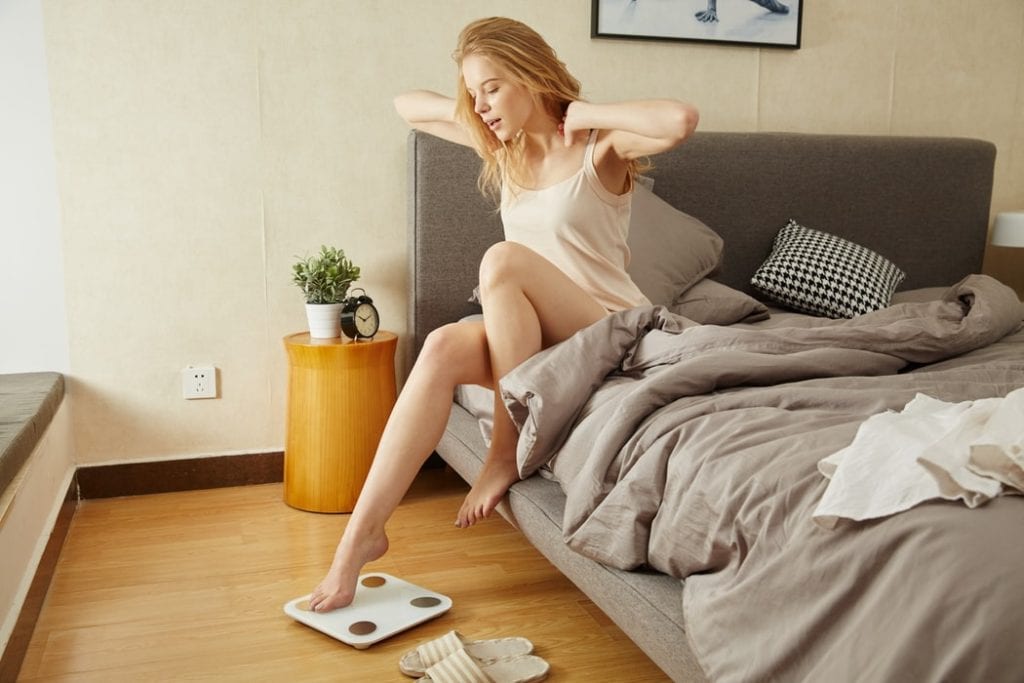5 Of The Best Ways To Track Weight Loss
01/12/2019
So you’ve decided you’re on a mission to lose as much weight as possible. You’re tired of clothes not fitting, and fed up of feeling sluggish and lacking in confidence. You’ve joined a gym, tidied up your diet, but how do you measure your weight loss progress?
In this article, I’ll tell you 5 of the best ways to measure a successful weight loss. I use all of the methods below with my personal training clients, but you may just want to pick a couple!
5 Of The Best Ways To Track Weight Loss

#1 Weigh Yourself
The obvious one is to weigh yourself! Are the numbers on the scales going down?
Your body weight consists of water, bone, carbohydrates, muscle mass, and fat mass. While there will be fluctuations, especially when it comes to water/carb weight, if you successfully create a calorie deficit, the numbers on the scales should be going down over time, i.e., an average weight loss of 0.5-1lb per week.
A few things to consider:
A) Purchase Some Good Weighing Scales
There are lots of scales that aren’t accurate and can deflate you when you don’t see results. Instead, I would recommend researching the best mechanical bathroom scales and reading reviews online before buying. This will put your mind at ease and stop you from wasting your money on some poor bathroom weighing scales.
B) Weigh Yourself Every Day
Do this first thing in the morning and take your weight every day (ideally at the same time each morning). Then at the end of the week, find the average. This is more accurate than weighing yourself once a week.
#2 Take Pictures
One of the best ways to assess progress is by looking at visual pictures. There’s a famous saying, “a picture says a thousand words” – and it’s so true, especially when it comes to weight loss!
With all of my one to one personal training clients, I take ‘before’ and ‘after’ pictures. This is to assess how much weight they’ve visibly lost.
I take four pictures, one front shot, two side shots (right and left side), and then a back shot. I recommend taking full body shots. For guys go topless and wear shorts, and for women wear a sports bra and shorts. Remember, nobody has to see the pictures but you, it’s for your reference so that you can see your improvements.
#3 Body Fat Callipers
Another great way to assess weight loss progress is to measure your body fat with calipers. Now there’s a real skill to this, and I’d recommend reading up and watching videos before trying to do it yourself. You can also go on a training course and learn how to do it.
That said, most people will hire a personal trainer and do what’s called a ‘biosignature’ course. This is where your trainer assesses your weight, does a body fat caliper test, and thorough overall analysis to help you. Your personal trainer then advises you on how to lose weight at a much more rapid weight.
#4 Fitness Test
While it does not directly measure your weight, assessing your fitness is still a good measure to use. As your weight comes down, your fitness will go up.
One of the ways I measure weight loss progress with my personal training clients is by doing a fitness test. Here’s how I do it:
1) I do one at the start of our training journey i.e., session one or session two.
2) Then I’ll do another one halfway through our sessions – typically session twenty.
3) Then finally, in the last session (session number 40), I will do a final test to see how much they’ve improved.
I measure cardio, strength, endurance, flexibility, etc. You can do this yourself, but if in doubt, go and hire a personal transformation body coach to assess you, or at least show you what to do.
#5 Clothes
This may be pointing out the obvious, but one of the best ways to measure the success of your weight loss journey is your wardrobe!
When you lose weight, your clothes will fit more comfortably, and you’ll be able to get in old pairs of jeans and wear dresses you’ve not worn for years, etc. There’s no doubt that your clothes are one of the best indicators as to whether you are achieving weight loss or not.
Also, I’ve worked with clients whos weight hasn’t necessarily gone down very much, but their entire body shape has changed! They’ve lost fat and built lean/toned muscle at the same time, so the scales haven’t changed much. Let’s say, for example, a client loses 8lbs of fat but then builds 4lbs of muscle, the scales will only reflect a -4lb loss! If all you go off is the scales, this may disappoint you! That’s why it’s good to do a combo of different weight loss assessments.
Final Words:
I would recommend using all of the above strategies to record your weight loss endeavour, or at the very least, pick 2-3. The more you can use, the more accurate you’ll be. Here’s how I do it with my personal training and group PT clients:
Weight – ask clients to take every day and then send me their average at the end of each week.
Pictures – I take a picture when we start, a picture halfway through, and then one at the end.
Body Fat Calipers – same as the pictures, I’ll do three recordings: beginning, middle, and end.
Fitness Test – the same as the previous two points above.
Clothes – this will be spoken about by the client who will notice changes as they go further into their weight loss endeavour.